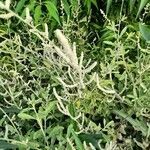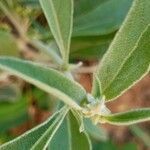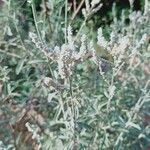Herb, perennial, erect to spreading, to 150 cm high, dioecious. Leaves alternate, indistinctly petiolate, lanceolate or narrowly elliptic to oblanceolate or spathulate, 15–77 mm long, 4–14 (–24) mm wide, with dense dendritic hairs on both surfaces or sparse above. Inflorescences dense terminal panicles, sessile, cylindrical, 10–85 (–135) mm long, 4–8 mm wide. Bracts ovate, 0.7–1.7 mm long, 0.5–0.9 mm wide, hairy. Bracteoles very broadly ovate, 0.9–2.5 mm long, 0.8–2.4 mm wide, ± hairy at apex, white to pink. Flowers bisexual. Male flowers: tepals 1.5–2.25 mm long, with outer 2 tepals ovate. Filaments delicate; rudimentary anthers subequal to the perianth. Female flowers: tepals 1.4–3 mm long, with outer 2 tepals obovate, hairy at base; inner 3 tepals narrowly elliptic to narrowly oblong, hairy throughout. Ovary small; style including stigmas 0.6–1.6 mm long; stigmas 2, rudimentary, papillose. Seed 0.7–1 mm long.
More
A shrubby plant which keeps growing from year to year. It grows 1 m high. The leaves are small and blue-green. They are leathery. The flowers are white. The seeds are very small. They are enclosed in short white fibres.
Erect or suberect undershrub, hoary-white, 2–4 ft. high
Habitats include roadsides and disturbed areas, skeletal soils in rocky areas, alluvial soils of water courses, and also coastal sand-dunes.
More
Dry thorn-bushland on finer soils in Kenya, where it is found at elevations up to 1,900 metres.
It is a tropical plant. It often grows on sandy soils. It grows in arid places.




